Federal Solar Tax Credit Timeline: Critical Deadlines Every Installer Must Know
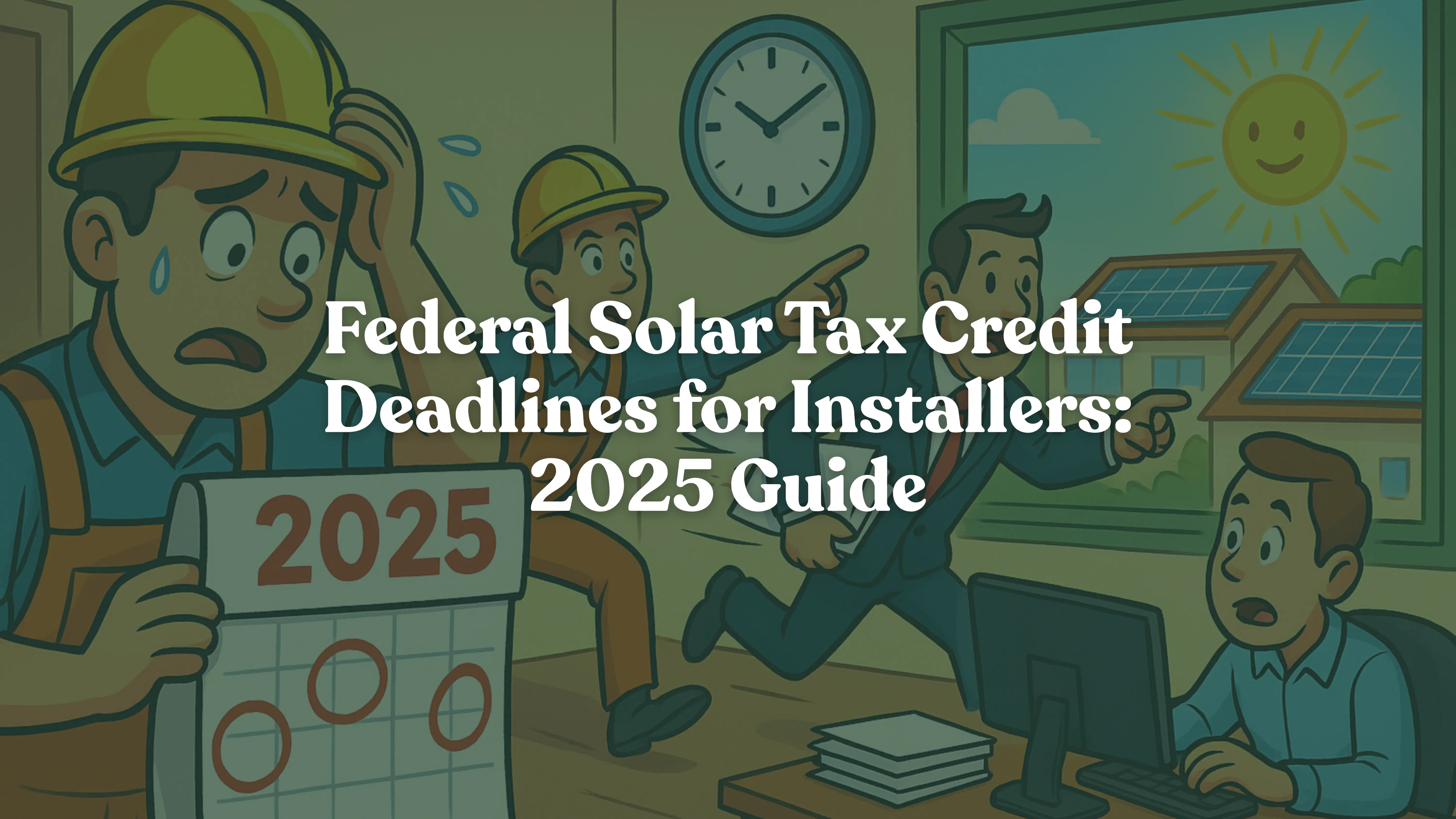
Federal Solar Tax Credit Deadlines: Don’t Miss These Critical Dates
Time’s running out, and solar installers across the country are facing the biggest deadline crunch in industry history. The federal solar tax credit landscape has fundamentally changed, and if you’re not tracking these critical dates, you’re leaving money on the table. Moreover, with the residential solar tax credit ending December 31, 2025, and commercial solar ITC deadlines rapidly approaching, understanding these timelines isn’t optional anymore. This guide breaks down every solar tax credit deadline you need to hit, from safe harbor requirements to FEOC compliance, so you can protect your customers’ savings.
The Residential Solar Tax Credit Deadline That Changes Everything
The 30% residential federal solar tax credit under Section 25D officially expires on December 31, 2025. There’s no phase-down, no extensions, and no second chances for installers or their customers.
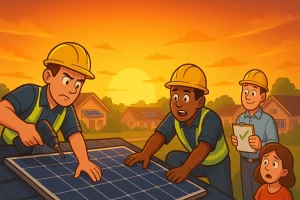
Signed on July 4, 2025, the One Big Beautiful Bill Act eliminated the residential solar tax credit after this year. Consequently, every system must be fully installed and operational by year-end to qualify for that 30% credit.
What does “operational” actually mean? According to IRS requirements, systems must be in a condition of readiness—capable of generating electricity. Furthermore, most installers push for Permission to Operate (PTO) from utilities. However, the safest approach remains getting that PTO before December 31st.
Your Solar Tax Credit 2025 Timeline Reality
The clock’s ticking faster than most realize. Here’s what installers are facing:
- Right Now: Installation queues are filling rapidly, with many installers booked through November
- Permitting: Additionally, AHJ reviews take 2-8 weeks depending on jurisdiction
- Utility Interconnection: Applications typically require 4-6 weeks minimum
- Installation: Meanwhile, weather delays and supply issues add unexpected weeks
- Inspection & PTO: Finally, the last steps take another 2-4 weeks
Therefore, signing contracts today without confirmed December installation dates means risking your customers’ entire tax benefit.
Commercial Solar Tax Credit: Your Safe Harbor Strategy
Commercial projects have more flexibility—but they also come with significantly more complexity. Although the commercial solar tax credit under Section 48E doesn’t end December 31, 2025, that date remains critically important.
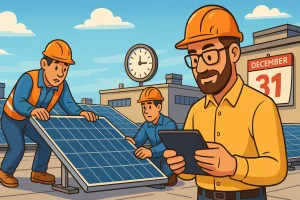
Specifically, projects beginning construction by December 31, 2025, can safe harbor at current rules without FEOC restrictions. However, miss that deadline, and you’re dealing with Foreign Entity of Concern requirements that disqualify major equipment options.
Understanding Safe Harbor Solar Rules
Safe harbor effectively locks in the 30% solar ITC based on when construction begins. For projects under 1.5 MW AC, you can establish safe harbor through either approach:
- 5% Safe Harbor Test: Spend at least 5% of total costs on qualifying equipment
- Physical Work Test: Begin physical work of significant nature on-site
Critical update: Treasury’s August 2025 guidance eliminated the 5% safe harbor for projects over 1.5 MW AC. Therefore, larger projects must now satisfy the Physical Work Test through meaningful construction work.
Critical Commercial Deadlines for Federal Solar Tax Credit
December 31, 2025: This represents your final deadline to safe harbor projects without FEOC compliance. Additionally, it’s your last opportunity to avoid heightened domestic content requirements starting in 2026.
July 4, 2026: By this date, projects must begin construction to qualify for the four-year construction window. Otherwise, you must have systems in service by December 31, 2027.
December 31, 2027: This absolute deadline applies to projects that began construction after July 4, 2026.
Consequently, missing the July 4, 2026 safe harbor means you’ve got under 18 months from signing to energized system—an extremely aggressive timeline.
FEOC Requirements: The 2026 Game Changer
Starting January 1, 2026, FEOC restrictions fundamentally change equipment procurement. Subsequently, projects not safe harbored in 2025 must prove 40% of manufactured product value comes from non-FEOC countries—specifically not China, Iran, Russia, or North Korea.
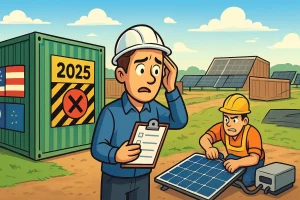
Moreover, that threshold increases 5% annually, reaching 60% by 2030. For battery storage, requirements prove stricter: 55% non-FEOC content in 2026.
Here’s the reality: most inverters, modules, and batteries currently come from FEOC countries. As a result, finding compliant equipment means longer lead times and higher costs. In contrast, projects safe harbored before December 31, 2025, bypass these requirements entirely.
Why Safe Harbor Solar Projects Now
For EPCs managing commercial projects, establishing 2025 safe harbor delivers critical advantages. First, you’ll avoid FEOC compliance headaches completely. Second, you’ll preserve domestic content thresholds for bonus credits. Third, you’ll secure a four-year construction window. Finally, you’ll maintain equipment procurement flexibility before tariffs spike costs.
Project Documentation That Protects Your Customers
The federal solar tax credit isn’t automatic—it requires comprehensive documentation. Therefore, your project files must include these essential elements:

For residential projects:
- Signed contracts with installation dates
- Interconnection agreements and PTO documentation
- Itemized invoices showing costs
For commercial safe harbor:
- Binding contracts for equipment with delivery dates
- Invoices demonstrating 5% cost incurred
- Physical work documentation
Importantly, the IRS has become increasingly strict about qualifying documentation. Consequently, customers will need Form 5695 for residential claims.
Your Action Plan for Solar Tax Credit Deadlines
Residential Pipeline: First, prioritize projects by completion feasibility. Next, build buffer time for delays. Additionally, communicate timeline risks transparently. Finally, decline projects that can’t finish by December.
Commercial Pipeline: Initially, identify which projects can safe harbor in 2025 and execute immediately. Then, order long-lead equipment now. Furthermore, document every milestone meticulously.
2026 Planning: Start building relationships with non-FEOC suppliers today. Simultaneously, understand your state incentive landscape. Moreover, adjust pricing models to reflect true costs. Finally, educate customers about the changing landscape.
2026 is coming fast. Explore how leading installers are preparing for the post-solar tax credit era, Click here;
Making Solar Work Without Federal Tax Credits
After 2025, residential solar becomes tougher to sell. The federal solar tax credit has hidden industry inefficiencies—high soft costs and inflated fees.
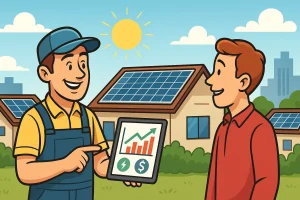
However, forward-thinking installers are adapting. This means streamlining operations and focusing on value. Fortunately, the solar value proposition remains strong—equipment costs have dropped dramatically, while utility rates continue climbing.
Consequently, the sales approach must shift from “take advantage of the tax credit” to “take control of your energy costs.” Projects in 2026 need longer payback periods. For commercial clients, energy savings become the primary driver.
Conclusion: Partner with Deadline Experts
Navigating the complex federal solar tax credit timeline requires expertise and reliable partnerships. Whether you’re managing the year-end residential rush or establishing safe harbor for commercial projects, these deadlines aren’t flexible—and mistakes inevitably cost thousands.
At EnergyScape Renewables, and supported by Sunscape we fully understand what installers and EPCs face in this unprecedented deadline environment. We specialize in supporting solar professionals with expert design services, engineering support, and project management that keeps installations on schedule.
From permit-ready designs that accelerate AHJ approvals to interconnection support preventing utility bottlenecks, we’re built to help installers succeed under pressure. Whether you’re completing residential projects before December 31st or structuring commercial safe harbor strategies, provides the technical backbone keeping your pipeline moving.
Don’t let these critical deadlines cost you valuable projects or customer trust. Instead, let’s talk about how we can support your team through the 2025 crunch and position you for continued success.

sjayakanth@energyscaperenewables.com